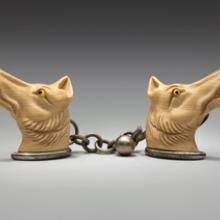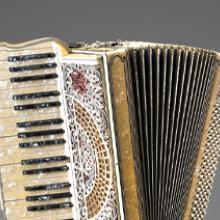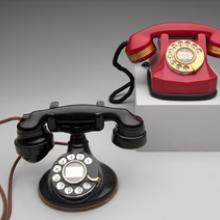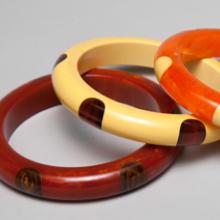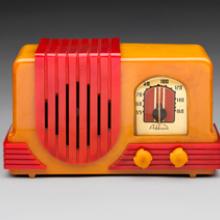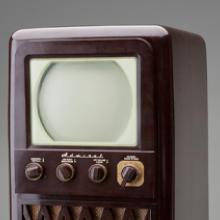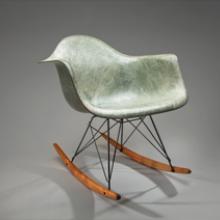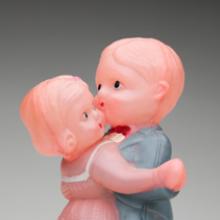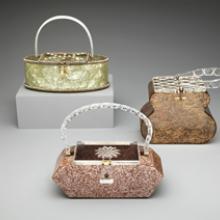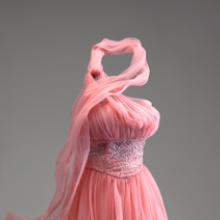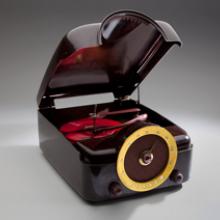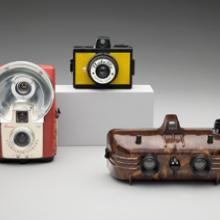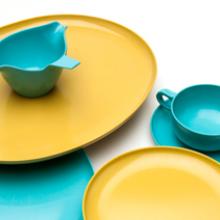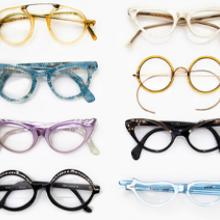International Terminal














Cape clasp c. 1875
Celluloid Manufacturing Co.
Newark, New Jersey
celluloid, metal
Courtesy of Julie Robinson Robards
L2013.1609.033
In the 1800s, ivory was used for all manner of things, from buttonhooks to boxes, piano keys, and combs. One of its most frequent uses was for making billiard balls. Celluloid, which could be rendered in creamy ivory hues, became the first semi-synthetic plastic alternative to ivory. English inventor Alexander Parkes developed an early version in the 1850s, which was refined by American John Wesley Hyatt in 1868. Hyatt invented the new material while attempting to create an alternative to ivory billiard balls.
Hyatt’s celluloid served as an adequate substitute for ivory, but it did not make very good billiard balls. Celluloid billiard balls lacked the bounce and resilience of ivory, and the material was highly volatile. The first balls Hyatt made produced a loud crack, like a shotgun blast, when they knocked into each other. Celluloid could, however, be easily made into a variety of practical and decorative items such as vanity sets, picture frames, jewelry, toys, and combs. To appeal to clerical and service workers, manufacturers even made celluloid cuffs and collars for men as an alternative to constantly having to wash, press, and starch dress shirts.
Accordion c. 1920s
Colombo & Sons Accordion Mfg.
San Francisco
celluloid
Courtesy of Skyler Fell, Accordion Apocalypse, San Francisco
L2013.1613.001
To make celluloid, the first semi-synthetic plastic, patented in 1870, plant cellulose was mixed with camphor, a derivative of the laurel tree, and nitric acid. The mixture was then combined with additives including pigments, stabilizers, and alcohol to form puffy dough. Next, it was pressed into blocks and sliced into thin sections. After being partially softened again by heat, it was stamped, pressed, or molded into a variety of goods. By replacing materials that were hard to find or expensive to process, celluloid democratized a host of goods for an expanding middle class market. Celluloid, its makers proclaimed, made it possible to produce counterfeits so exact that they deceived “even the eye of the expert.”
Celluloid could be made in rich creamy tones to emulate ivory; mottled in browns and ambers to resemble tortoiseshell; traced with veining to look like marble; infused with the bright colors of coral; blackened to look like ebony or jet; and produced with a pearlescent luster to resemble mother-of-pearl. Manufacturers offered piano keys from celluloid that resembled ivory or mother-of-pearl by the late 1800s. In 1924, chemist William Lindsey discovered that the chemical reaction of mercury on celluloid produced a beautiful pearlescent effect. Prior to this, the technique of reproducing mother-of-pearl finishes involved repeated applications of ground fish scale and/or mica to the surface of celluloid.
(left to right)
Desk phone, model 102 c. 1920s
Western Electric
Chicago
Bakelite, metal, fabric
Collection of the JKL Museum of Telephony, Mountain Ranch, California
L2013.1618.001
Desk phone, model 40 c. 1940s
Automatic Electric
Illinois
plastic, metal
Collection of the JKL Museum of Telephony, Mountain Ranch, California
AE40
L2013.1618.002
Plastic provided the perfect medium for telephone design. Bakelite allowed the telephone to become a commonplace item in homes across the United States. Before synthetic plastic, telephones were costly, decorative items constructed from wood, metal, and hardened rubber. Mass-produced Bakelite phones displayed simplified designs. The first phones made of plastic, introduced in the United States in 1925, were also the first to have the handset resting on the body of the telephone. Western Electric was the major manufacturer of telephones and telephone-related equipment in the United States for almost a century.
Polka dot bracelets c. late 1920s–40
United States
Bakelite or Catalin
Anonymous lender
L2013.1617.005–.013,.015–.018
Bakelite is the brand name for the first thermosetting plastic that sustained a permanent, fixed shape. It was invented by the Belgian chemist Leo Baekeland in New York in 1907 and manufactured by the General Bakelite Company, later the Bakelite Corporation. Bakelite’s uses ranged from purely industrial to decorative. True Bakelite, derives from phenol-formaldehyde resins or gas and coal derivatives. It tends to be dark and opaque due to added fillers that range from rags to cotton and wood. When the patent for Bakelite expired in 1927, it was acquired by the Catalin Corporation, which produced much of the jewelry referred to as Bakelite today. Catalin, although very similar to Bakelite, contained no fillers and was produced in a brighter range of solid, translucent, and marbleized colors.
Plastic costume jewelry became popular after World War I. Prominent designers such as Coco Chanel and Elsa Schiaparelli designed plastic pieces in the 1920s, which made it highly desirable and fashionable. Such costume jewelry was initially offered in upscale department stores at costly prices. By the 1930s, a much larger audience began to appreciate and acquire Bakelite jewelry. Forms ranged from floral bracelets to whimsical pins and necklaces in the form of fruits and animals.
Addison model 2A radio c. 1940
Addison Industries, Ltd.
Toronto, Canada
Catalin
Courtesy of PAB
L2013.1606.003
The world’s first radio broadcast took place in the Netherlands in 1919. This was followed by broadcasts in the United States a year later, then England and Germany in 1922. By 1931, radio as a public service broadcasting medium had spread all over the world. The radio became the most important source of news and entertainment. Early radios were large pieces of expensive furniture. By the 1930s, when radio popularity reached its zenith, table radios were among the first goods to be made of Bakelite. Shortly after, a similar plastic, Catalin, which could be dyed in a variety of brighter colors, replaced Bakelite.
As more households purchased radios in the 1930s, radio design took center stage. Not only did Americans want something to listen to, they also wanted something visually attractive to display in their homes. The automobile, airplane industry, and Art Deco style influenced radio designers. Streamlined designs and unique shapes, such as world globes, were among the interesting forms created.
Model 24A12 Admiral Television 1948–49
Admiral Continental Radio & Television
Chicago
Bakelite, metal, glass
Courtesy of Tom Albrecht
L2013.1610.001
This television is the largest piece of plastic cast from Bakelite. Developed in 1907, Bakelite was the first entirely synthetic thermosetting plastic. All plastics are classified according to their molecular structure and their response to high temperatures. Some plastics derive from natural sources including horn; others, such as celluloid, are semi-synthetic, or the result of chemical action on a plant-based substance. Synthetic plastics are chemically engineered from derivatives of coal or oil. Plastics can be further categorized by how they are affected by heat: thermoplastics, like candlewax, can be reshaped when heated; thermosets such as Bakelite, sustain a fixed shape and cannot be melted back into a liquid form.
Bakelite reached its height of popularity from the mid-1920s to 1950. Manufacturers used the material to make a variety of objects from jewelry to household appliances, radios, and later televisions. By the 1950s, more colorful, flexible plastics began replacing Bakelite.
Armchair 1950
Designed by Charles (1907–78) and Ray Eames (1912–88)
Herman Miller, Inc.
United States
fiberglass-polyester, metal, wood
Courtesy of Steve Cabella
L2013.1601.001
New technologies developed during World War II were applied to the mass production of domestic goods after the war. Furthermore, the 1950s introduced revolutionary developments in the field of plastics that inspired leading designers of the era. Chairs, in particular, caught the imagination of many designers who sought to create pieces that were strong and durable, yet attractive and comfortable. Charles and Ray Eames, two of the most influential mid-century designers, pioneered the use of fiberglass in chair design in 1948. Previously, the material was used to fabricate aircraft parts during World War II. These lightweight fiberglass chairs would never chip, peel, or stain. First manufactured by Zenith and sold by Herman Miller, the molded fiberglass shell chairs were offered with or without arms and in a variety of colors. Customers could choose their preferred chair bases: wooden, metal, or rocking. The chairs, which were in production for forty years, were mostly purchased for offices and institutions.
Wind-up toy c. 1945–52
Japan
Celluloid
Courtesy of Julie Robinson Robards
L2013.1609.021
After World War II, manufacturers took advantage of a variety of novel plastics to create children’s toys. Less costly, plastic replaced toys made from traditional materials including wood, cloth, and tin. Injection-molded plastic allowed toys to be easily mass-produced. Millions of simple toys such as cars, trains, and dolls appeared at five-and-dime stores across the country, as well as in Cracker Jack snacks and cereal boxes.
Handbags 1950–55
Florida Handbags or Patricia of Miami
Miami
Lucite, metal, rhinestones
Courtesy of Danielle Originals by Danielle Kaplan, San Francisco
L2013.1605.005, .007, .008
German-based Rhom and Haas developed acrylic resin, a crystal-clear thermoplastic, in 1931. DuPont introduced their brand of acrylic plastic in 1936 under the trade name Lucite. Lucite could be easily molded and sculpted, enabling designers to make purses in fun shapes, such as hatboxes, beehives, drums, and guitars. Plastic handbags, created by leading designers, appeared in upscale department stores at the close of the 1940s. By 1950, the plastic handbag became extremely stylish. Less expensive acrylic purses were offered to a broad audience. Hundreds of different styles were created. Bags were laminated with glitter, multi-colored confetti, and other colorful materials on their rigid plastic sides. Others were studded with rhinestones or hand carved.
Dress c. 1950s
United States
nylon, rayon, beads
Courtesy of Vintage a la Mode, San Francisco
L2013.1608.001
Nylon, the first entirely synthetic fiber, derives from coal. It consists of long, synthetic filaments that can be spun, then woven or knitted. Invented in 1935 by a chemist working for DuPont, the company proclaimed it “as strong as steel, yet as fine as a spider web.” It was first used for toothbrush bristles in 1938. Nylon eventually became the new “silk replacement,” overshadowing rayon.
As hemlines continued to rise throughout the 1930s, silk and rayon stockings became a necessary part of every woman’s wardrobe. But such stockings were delicate and prone to runs. In response, DuPont initially focused on using nylon for ladies’ fully-fashioned hosiery. DuPont caused quite a sensation when it pronounced May 16, 1940 “Nylon Day” by offering nylon stockings to the public. Women lined up for hours in front of storefronts. Four million pairs of nylons stocked in stores throughout the country sold out within two days. World War II, however, quickly halted sales of nylon hosiery; instead nylon was used to make parachutes and war supplies. It was not until 1945 that nylon stockings once again appeared on store shelves. Eventually, nylon made its way into everything from upholstery to women’s eveningwear and undergarments. In 1969, U.S. astronaut Neil Armstrong planted a nylon flag on the moon.
Cobra-matic record player and radio 1950
Zenith
Chicago
Bakelite, metal, paint
Courtesy of John Eckland
L2013.1614.001
Sound recordings were made from wax, and later, celluloid cylinders in the late 1800s and early 1900s. Flat, round records made from shellac, a cotton compound, powdered slate, and a wax lubricant were offered beginning around 1900. These records, which remained common for a half century, were brittle, with varied sound quality.
A German chemist developed an early version of vinyl in 1872. In 1926, scientist Waldo L. Semon discovered the material while researching a synthetic adhesive. Shortly after, vinyl-based products such as insulated wire, raincoats, and shower curtains appeared on store shelves. Vinyl’s most famous use, however, was for making recorded music. In 1930, the first vinyl record was pressed and played for select RCA executives, but nearly two decades passed before vinyl records became mainstream. Sav-Way Industries of Detroit, Michigan, made early use of vinyl in recorded music with their Vogue picture records, which were produced for less than one year. In a complex process, a central core aluminum disc was sandwiched between colorful paper illustrations and pressed in vinyl.
In 1948, Columbia introduced the LP, or long playing record, crafted from lightweight, unbreakable vinyl with a sound quality that surpassed 78s made from shellac. A year later, RCA Victor introduced the smaller, 7-inch, 45-rpm record, the choice for popular music singles as it contained less than five minutes of playing time per side. Vinyl LPs and 45s soared in popularity during the 1950s and remained standard until the late 1980s.
(clockwise)
Brownie Star Flash camera 1958–60
Eastman Kodak Co.
Rochester, New York
plastic, metal
Courtesy of Geoff Turner, Random America
L2013.1607.014
Babette camera c. 1950s
Hong Kong
Plastic
Courtesy of Geoff Turner, Random America
L2013.1607.009
3-D camera c. 1930s–40s
United States
plastic
Courtesy of Geoff Turner, Random America
L2013.1607.010
The art of photography owes much to the invention of plastics. Celluloid had a profound effect on the evolution of still photography, and later, moving picture film. The earliest cameras were based on the principle of a glass plate coated with a light sensitive emulsion of silver nitrate. Film development posed a challenge; the notion of replacing the rigid film with a flexible material first occurred in the late 1880s. A chemist working for George Eastman’s photography supply house in Rochester, New York, devised a method of producing bendable, photographic film from cellulose nitrate in 1889. This film could be sent to Kodak for development so that hobbyists no longer had to worry about developing their own film.
Early cameras were large, bulky objects that had to be mounted on tripods. In 1900, Kodak introduced the Brownie, the first point-and shoot-portable camera. The camera, which sold for one dollar with film that cost fifteen cents per roll, allowed greater numbers to easily take pictures wherever they traveled. Not long after, the Brownie and other portable cameras were molded from Bakelite and other plastics.
Florence dinnerware c. 1955–60
Prolon
Florence, Massachusetts
melamine
Courtesy of Steve Cabella
L2013.1601.002.01–.06
Melamine, or formaldehyde resin, was developed in the 1930s, though it was not used in the domestic market until after World War II. The Ohio chemical company American Cyanamid, created the first melamine dinnerware for the U.S. Navy during World War II. The shatterproof, lightweight tableware proved to be a practical choice on rough seas. The plates also kept food warmer than metal. Initially apprehensive about offering plastic dinnerware, American companies began experimenting with plastic as an alternative to china in the early 1950s. Makers commissioned well-known designers to create their collections. The sleek appearance of plastic and its inability to chip or break appealed to consumers. For the first time in history, people began to replace their china with plastic dinnerware. Advertisements often featured cups and plates being dropped to no ill effect. Because it can absorb strong dyes, brightly colored mix-and-match tableware became mainstays in kitchens across the country. Although a success, melamine had its drawbacks, as the tableware was prone to scratches.
Eyeglasses c. 1915–70s
United States or Europe
plastic, glass, metal
Courtesy of the Foundation of the American Academy of Ophthalmology and Museum of Vision, San Francisco
L2013.1611.004, .009, .012, .014–.017, .023, .025, .026, .028, .029
In 1876, Spencer Optical introduced the first eyeglass frames made from celluloid in the United States. Prior to synthetic plastic, frames were made primarily of metal, hardened rubber, or were handcrafted from tortoiseshell and horn. Plastic was a less costly alternative to these materials and more comfortable to wear. The most popular colors were black and imitation tortoiseshell.
Most people viewed early eyeglasses as medical devices that needed proper fitting, not as stylish accessories. In 1917, silent film actor Harold Lloyd made the wearing of eyeglasses, particularly, large, round faux horn or tortoiseshell spectacles, fashionable. Ironically, he did not actually need eyeglasses, but wore them in his films as part of his onscreen persona.
Beginning in 1955, American manufacturers teamed up with designers to introduce brand-named spectacles to the market. Around the same time, the formula for plastic lenses was perfected and its use widespread. People who needed a large amount of magnification or “high-index” lenses were particularly eager for plastic lenses to become available. Glass, high-index lenses were especially heavy and hard to wear, but obtaining the same magnification in plastic proved difficult. The first plastic high-index lenses became available in Japan during the 1980s.
